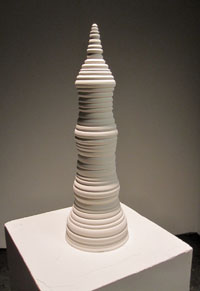Auburn Isaak is a musician as well as an artist. Lately,
her work has taken an interest in the possibilities of what we hear but cannot
see and if we could see them, how would we perceive them? Presently her work is
displayed in the Nightingale Gallery exhibition called Concinnity. All of her
works touch on this interest in visual waveforms. I first learned of her
interests in another art class as she made a concept study of what would become
her senior exhibition. It is a small waveform made of beads and Popsicle sticks
hanging from the ceiling in the hall with the art lockers in Loso. A direct
light would shine upon it to cast a clear and distinct shadow against the wall,
mimicking the sound wave. I was not
surprised to see her simple project expanded into a series of serious artworks
for the exhibition.
Her sculpture in the gallery, titled Soundescape, I found not only the most
striking of her work but also best fits the gallery’s exhibition name. It begins
with a mirror-topped table roughly three feet tall. Upon the table are eleven
tower-like stoneware sculptures. Isaak’s forms identify with the dictionary definition
of sound wave, “a wave of compression and rarefaction, by which sound is
propagated in an elastic medium such as air.” She accomplished this in a manner
that causes each ring of material in the sculptures to appear compressed together. Another way she
successfully created the waveform is by illustrating its rarefaction – a term that
describes a reduction in a sound wave’s density. In this case, these figures
possess varying circumferences, as the ridged material grows larger then
smaller, and then larger again preventing a true conical shape.
All forms are white except for two. One of those
exceptions is a medium-dark shade of gray while the other is not only bright
red, but is a smooth triangle. However, the descriptions thus far give an
incomplete understanding of Soundescape.
As
previously noted, the sculptures stand on a mirror. The choice of the mirror is
the key to the purpose of the shapes. As stated earlier, the dictionary
describes sound waves as something that propagates
through an elastic medium. Naturally, mirrors reflect. They do not propagate
light in the manner that sound is propagated. However, because of the nature of
these sculpted forms placed directly on the mirror causes an illusion of
transmission. In other words, the reflected light transforms them from somewhat
cone-shaped structures into waveforms, which to hover in space.
The concinnity of Isaak’s waveforms is obvious. Isaak
placed these forms on the mirror with deliberation. It is clear that placement
of each form is representational of harmony in sound. In music, for example, to
have harmony is to produce chords with a pleasing effect on the ear. In
visualizing sound, we are to have that pleasing effect on the eye. As Isaak
would arrange her fingers on a piano to play a chord or chord progression, she
meticulously placed her sculptures on the mirror. Once placed, the mirror
completes the images to produce the chord.
The difference in color between the gray wave and the
red wave remind me of counterpoint in music. A counterpoint is when two melodies,
which sound different separately and work independently, but harmonize when
played together. The white waves could be considered a melody on treble clef
and the gray and red waves are a melody on base. In the sound editing business,
particularly in Digital Audio Workflows, sound can be ‘visualized’ in a two
dimensional fashion. Isaak has taken that further into the three dimensional
world, not only creating the wave forms compression and rarefaction in their
basic shape, but also of their propagation through the mirror, working
harmoniously as music should.
See also: ArtsEast Juried Competition, Oregon East, EOU "Concinnity"
 |
| Auburn Isaak. Soundescape (detail). Mixed media. 48" x 84" x 60" (2012). |
 |
| Auburn Isaak. Crescendo. Mixed media. Variable Dimensions (2012). |
 |
| Auburn Isaak. Cone 3. Stoneware. 23”x7”x7” (2012). |
No comments:
Post a Comment